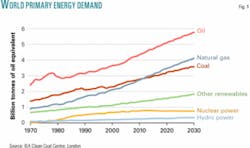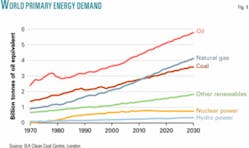Advocates of clean coal are pushing that technology in the UK as the ideal solution to carbon management and the answer to Europe’s need for a diverse energy portfolio.
In a recently released report, engineering firm Mitsui Babcock urged the UK government to embrace clean coal to cut carbon dioxide emissions while ensuring Europe’s energy security.
The Crawley, UK, firm based its arguments on data from the International Energy Agency (IEA), the UK Department of Trade and Industry (DTI), the Royal Academy of Engineering, Princeton University, and others.
IEA’s World Energy Outlook 2004 predicts a 60% energy demand growth worldwide during 2002-30, with almost 90% of that from fossil fuels (Fig. 1).
With gas prices rising and clean renewables currently intermittent as energy suppliers, the government “must” invest in clean coal technology, Mitsui Babcock warned, particularly to close an electric power energy gap that could be as much as 18-29 Gw by 2015 because of expected coal and nuclear plant closures.
While the report also urged the government to lead investment in nuclear power to replace existing plants, it noted that nuclear is a long-term solution. It pushed clean coal as the only short-term and long-term solution to environmental, economic, and security-of-supply challenges.
Because clean coal produces electricity at lower cost than do gas or renewables, the report stated, it also could stabilize energy prices.
Power consumption up
Worldwide, electric power consumption is expected to increase by 2.5%/year to 31.7 trillion kw-hr in 2030 from 16.1 trillion kw-hr in 2002. Demand in developing countries will grow by 3.5%/year.
By 2030, the global power industry will need 4,800 Gw of new capacity to meet demand and replace aging infrastructure, requiring total installed capacity to increase to more than 8,000 Gw from 3,500 Gw.
Diverse energy sources are needed to meet this demand. In 2002, coal-fired power plants met 39% of global electricity needs; gas provided 19%, nuclear 16%, hydro 15%, oil 6%, and other renewables 3%.
IEA says worldwide coal reserves represent almost 200 years of coal production at current rates, compared with 36-44 years of oil reserves and 66 years of gas reserves.
Increasing gas use for power generation would quicken gas depletion, Mitsui Babcock argued.
Emissions issues
More than 60% of the projected energy growth will be in developing countries, where CO2 emissions are predicted to overtake those of Organization for Economic Cooperation and Development countries in the 2020s.
To offset these emissions, the G8 nations meeting at Gleneagles in Scotland in 2005 committed to the research and development of carbon capture and storage (CCS) projects and emissions trading programs, and the UK embraced a carbon abatement technology (CAT) strategy incorporating a 10-point action plan, which Mitsui Babcock supports.
The UK’s 2003 Energy White Paper earlier had called for greater energy efficiency, increased renewables use, and switching to natural gas from coal. It called for almost 60% of the generation to be from gas by 2020 and 38% from new plants built during 2003-20.
However, gas-fired generation investment has been blindsided by increasing gas prices, and progress in renewables slowed by planning delays (for onshore wind) and costs (for offshore).
Furthermore, the company charges that the UK’s emissions-trading scheme is lagging.
“The introduction of emissions trading in January 2005 failed to significantly change the mix of generation or to trigger investment in CAT projects to reduce emissions,” Mitsui Babcock reported. It said the government’s CAT strategy during 2008-15 should fund CCS demonstrations proving second-stage clean coal technology that removes most emissions. These demonstrations should include amine scrubbing and oxyfuel firing on hard bituminous coals to parallel the likely demonstrations in Germany and elsewhere on lignite.
During the UK presidency of the European Union, Tony Blair, following discussions with the Chinese government, had announced the EU-UK near-zero emissions for coal project and agreed to fund a feasibility study to demonstrate a near-zero emissions coal-fired power plant technology in China and Europe by 2015.
Because many new or replacement carbon-abated power plants will need to be operational by 2015, the company urged that they be started in the next 5 years.
The report recommends government assurance that all future coal plants be ‘capture-ready’ and compatible with that CCS technology, that the UK lead clean coal investment, and that the National Allocation Plan CO2 Allowances trigger industry investments in clean coal as well during 2008-12.
Prompt action is necessary before the government completes its energy review, Mitsui Babcock said. In its policy, the UK should include each technology’s suitability for global application, export potential, and worldwide environmental impact; a mandate for maximum and minimum levels for each energy source in its portfolio; and acknowledgment of the relative prices of each along with the timescales required to build up their capacity.
Cutting CO2
The report also cites data from Princeton Environmental Institute (PEI), which in 2004 said it would be necessary to cut emissions by 7 billion tonnes/year to stabilize global CO2 emissions at current levels. PEI predicted that these levels would triple by 2054 if nothing were changed (Fig. 2).
PEI suggested 14 efficiency gains (wedges)-each of which alone could remove 1 billion tonnes/year of emissions [http://www.Princeton.edu/~cmi/resources/CMI_Resources_new_files/Wedges_Concept_Game_Materials_2005.pdf]. Elements of each strategy could be employed to jointly enable a flat, no-emissions-growth path. These gains include:
• CCS-Applying CCS to 800 coal-fired power plants through 2054. Plant efficiency improvements could achieve reductions of about 20-25% and biomass cofiring, about 20% of this wedge.
• Transportation efficiencies-Doubling the fuel efficiency of 2 billion cars to 60 mpg. There currently are 600 million cars or other vehicles in the world, with 2 billion predicted by 2054.
• Fuel-switching-Replacing 1,400 coal-fired electric power plants with natural gas-powered facilities, adding a gas amount in 2054 that would almost equal today’s entire world gas usage. This would require the equivalent of bringing one Alaska gas pipeline on line every year for 50 years, Mitsui Babcock calculated, or 50 large LNG tankers docking and discharging every day.
• Nuclear-Building an additional 700 nuclear plants in the next 50 years-almost twice the current global nuclear power capacity of today’s 400 nuclear plants-to replace coal-fired electric power plants.
• Wind-Increasing wind electricity capacity by 50 times relative to today’s, for a total of 2 million large windmills, which would require a land area about four times that of the entire UK.
• Solar-Using 40,000 sq km of solar panels to produce hydrogen for fuel-cell cars. PEI said this would require an area “about the size of New Jersey” (about 230 times the area of London, Mitsui Babcock calculates). In addition, nuclear, wind, and solar options would require backup sources.
• Natural sinks-Eliminating tropical deforestation and creating new plantings on nonforested land to quintuple current planted areas, requiring that new plantings have a total area 25 times that of the UK. ✦


